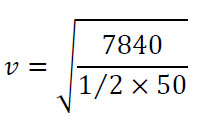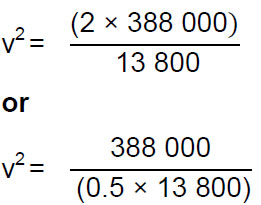Physics Energy Practice Exam Questions
Energy Practice Exam Questions
Energy is the "stuff" that allows things to happen or change. It's like the fuel in a car that makes it go or the electricity that powers your phone. In physics, we use the term "energy" to describe this ability to make things happen or do work.
Download and print our practice exam questions on the physics topic of energy.
Learn more

Visit our Energy page for revision notes and videos to help you study.
Energy Practice Exam Worksheet
Practice exam style questions on energy.
Scroll down to reveal answers below.
Click to reveal answers
| Question | Answer | Extra information |
| 1 | any two from:
bungee rope may snap rope may extend too much student may land in the river [2 marks] |
|
| 2 | gravitational potential [1 mark] kinetic [1 mark] elastic potential [1 mark] |
correct order only |
| 3 | ½ x 40 x 35² [1 mark] 24 500 (J) [1 mark] |
accept 24,000 (J) (2 significant figures) allow 24,500 (J) with no working shown for 2 marks |
| 4 | g.p.e. = mass x gravitational field strength x height [1 mark] | accept Ep = mgh |
| 5 |
Ep = 50 x 9.8 x 20 [1 mark] 9800 (J) [1 mark] |
allow 9800 (J) with no working shown for 2 marks
answer may also be correctly calculated using W = Fs ie allow W = 490 x 20 for 1 mark or answer of 9800 (J) using this method for 2 marks |
| 6 | 7840 (J) [1 mark] | allow ecf from '11.2' |
| 7 | 7840 = ½ x 50 v² [1 mark]
17.7(0875)(m/s) [1 mark] 18 (m/s) [1 mark] |
accept ecf from '11.3' correctly calculated for 3 marks allow 18 (m/s) with no working for 2 marks answer may also be correctly calculated using v² - u² = 2as |
| 8 | extension = 35 (m) and conversion of 24.5 kJ to 24500 J [1 mark] 24 500 = ½ x k x 35² [1 mark] 40 [1 mark] |
allow 40 with no working shown for 3 marks an answer of '16.2' gains 2 marks |
| 9 | weight (lifted) or height (lifted) [1 mark] |
|
| 10 | any two from:
calculate a mean spot anomalies reduce the effect of random errors [2 marks] |
|
| 11 | as speed increases, the efficiency increases [1 mark]
(but) graph tends towards a constant value [1 mark] |
accept efficiency cannot be greater than 100% |
| 12 | heating the surroundings [1 mark] | |
| 13 | 0 (%) [1 mark] | |
| 14 | chemical [1 mark] kinetic [1 mark] |
in this order only |
| 15 |
Ek = 0.5 x 80 x 12² [1 mark] Ek = 5760 (J) [1 mark] |
an answer of 5760 (J) scores 2 marks |
| 16 | power = work done / time [1 mark] | allow P = W/ T |
| 17 | 200 = W/1800 [1 mark] W = 200 x 1800 [1 mark] W = 360 000 (J) [1 mark] |
an answer of 360 000 (J) scores 3 marks
|
| 18 | 11 - 9.5 = 1.5 (m/s) [1 mark]
|
an answer that rounds to 15.8 (%) scores 2 marks
allow a change in speed between 1.2 and 1.5 (m/s) allow an answer consistent with their change in speed an answer of 16 (%) scores 2 marks |
| 19 | maximum speed is lower [1 mark]
because maximum power output of cyclist is constant [1 mark] (but) additional work is done (against gravity) [1 mark] |
allow maximum force on pedals is constant
do not accept additional work done against friction or air resistance |
| 20 | P = 12 000 / 8.0 [1 mark]
P = 15 000 (W) [1 mark] |
an answer of 15 000 (W) scores 2 marks |
| 21 | energy is transferred in heating the surroundings [1 mark] friction causes energy to be transferred in non-useful ways [1 mark] |
|
| 22 | gravitational potential energy = mass x gravitational field strength x height [1 mark] | allow Ep = m g h |
| 23 | Ep = 280 x 9.8 x 14 [1 mark] Ep = 38 416 (J) [1 mark] Ep = 38 000 (J) [1 mark] |
accept 38 000 with no working shown for 3 marks
|
| 24 | m = 1.2 × 2.3 × 104 [1 mark] m = 27 600 (kg) [1 mark] |
an answer of 27 600 (kg) scores 3 marks
allow an answer of 28 000 (kg) or 2.8 x 104 (kg) |
| 25 | mass of air passing the turbine blades halved which decreases kinetic energy by a factor of two [1 mark]
(wind speed is halved) decreasing kinetic energy by a factor of four [1 mark] so kinetic energy decreases by a factor of eight [1 mark] |
allow power output for kinetic energy throughout |
| 26 | 388 000 = 0.5 x 13 800 x v² [1 mark]
v² = 56.2 [1 mark] v = 7.50 (m/s) [1 mark] |
an answer that rounds to 7.50 (m/s) scores 3 marks
this mark may be awarded if P is incorrectly / not converted this mark may be awarded if P is incorrectly / not converted
an answer that rounds to 7.50 (m/s) only |

 [1 mark]
[1 mark]
